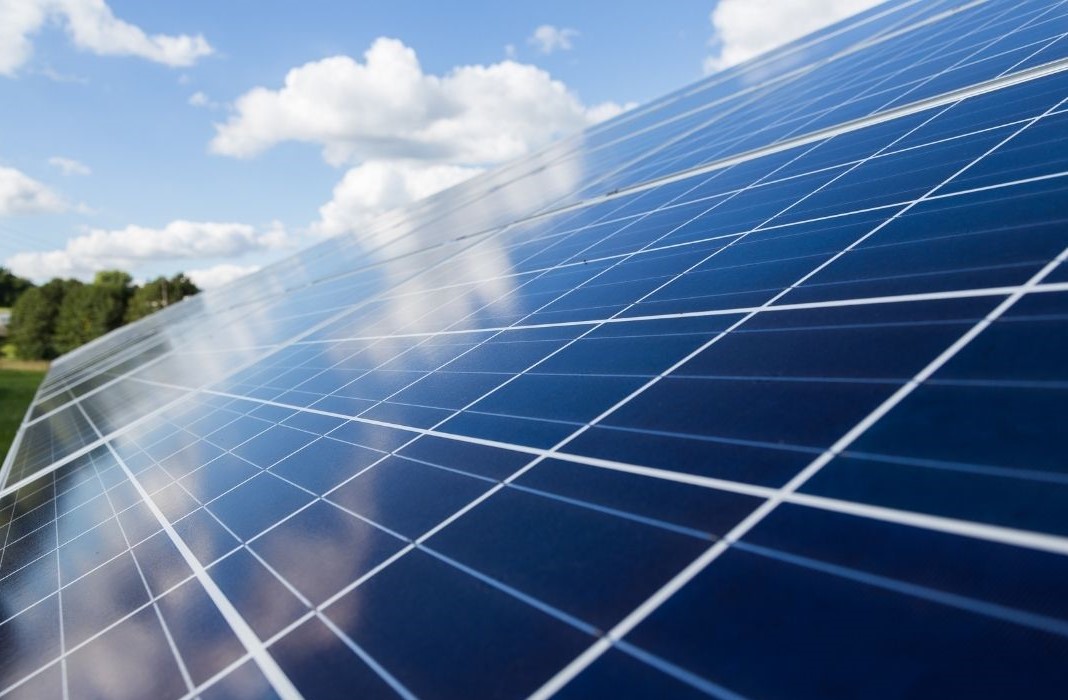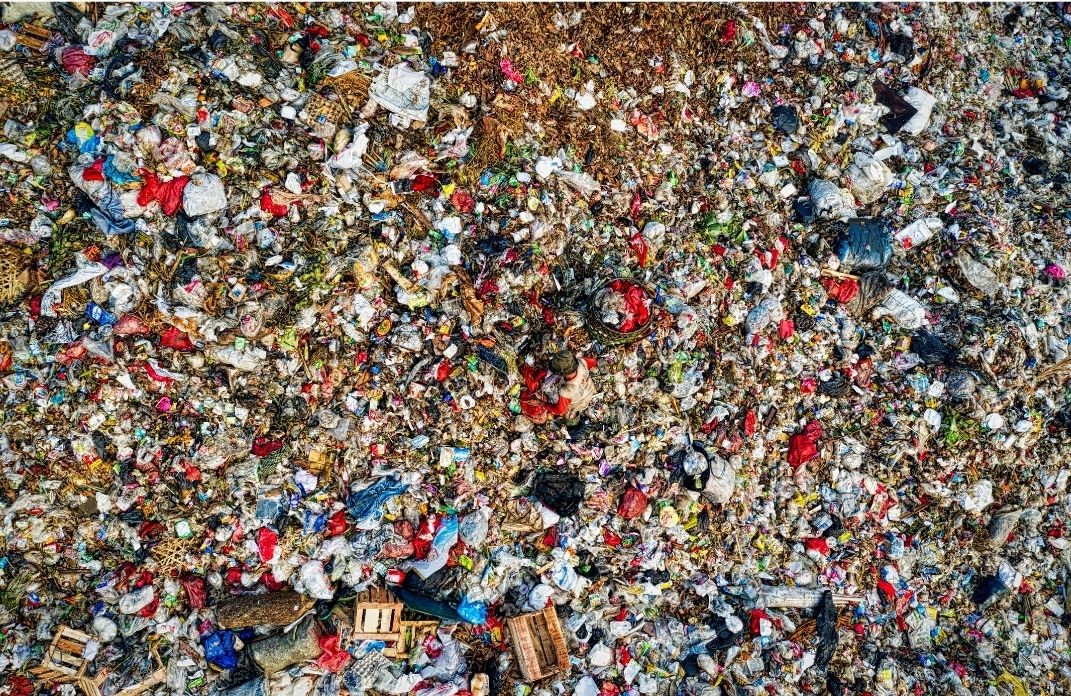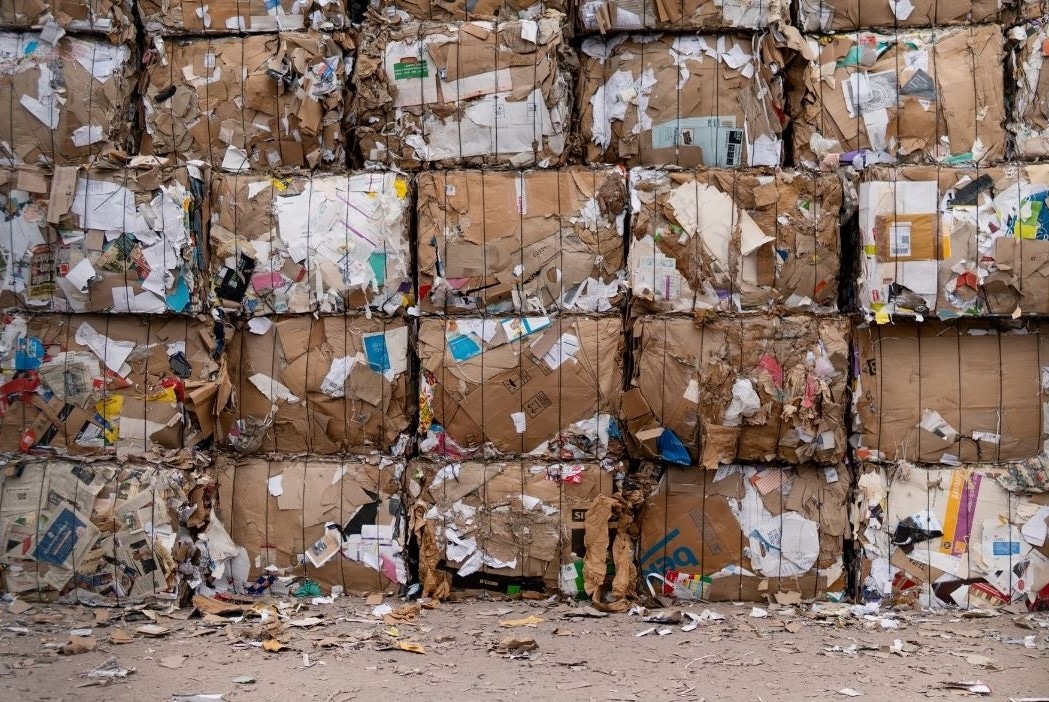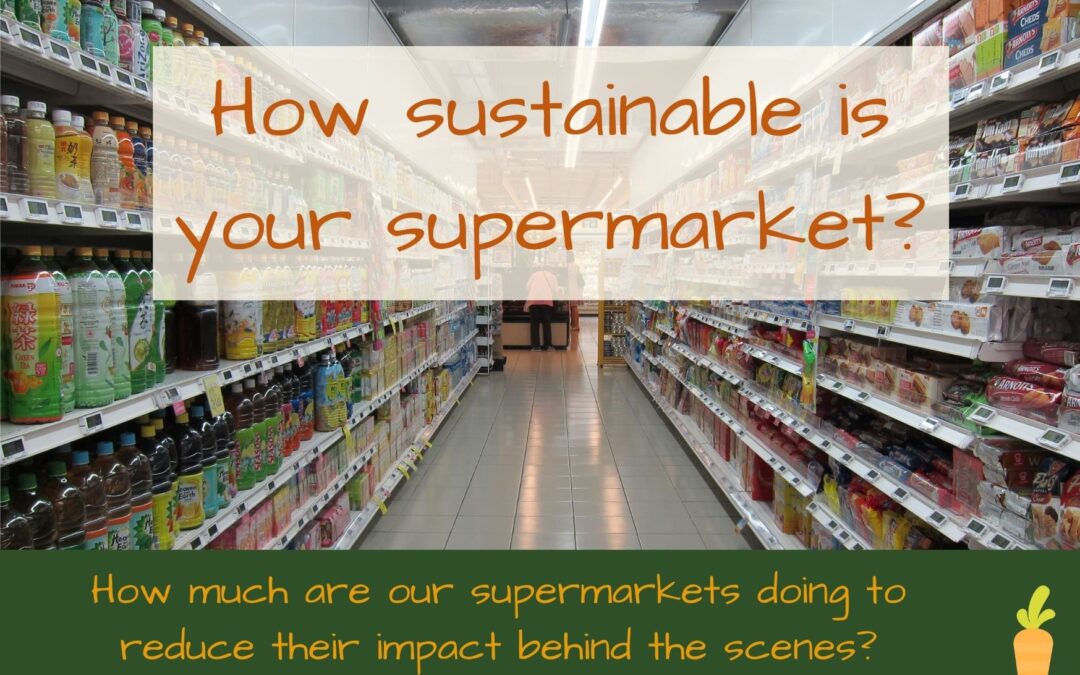How do you feel about your supermarket?
It seems we all expect our supermarkets to lead the way in helping us to make more sustainable choices. We all want a ‘sustainable supermarket’. How do you feel yours is doing?
It’s definitely true that the easier it is for the general public to get hold of low packaging and sustainable products, the more of us will make this essential shift.
So how do you know whether your supermarket is the right one for you on your journey to sustainability? We can look on the shelves at how much of their products are plastic free, but what about their supply and production lines? How is our store powered, and are they working towards goals that I care about? This is not easy to see from inside your supermarket…
Luckily, companies like these are expected to tell us what they are up to as a form of Corporate Responsibility reporting, so, being the nerd that I am, I’ve had a read of these reports, and a couple of other independent sources assessments, summarised the key points and come up with a ranking so that you don’t have to. You’re welcome!
Supermarket sustainability report quality
The supermarkets vary in the quality of their reports. Around half have a full report you can download, others have a series of webpages containing stats and information which has made a direct comparison pretty hard.
In terms of reports, Morrisons felt very transparent, with previous years numbers displayed so we can see progress and breakdowns of some of the numbers into details.
Unfortunately, Asda’s website was misbehaving, and only the headlines were visible as all the reports and details pages were displaying errors. They’ve shown up low scored because of this. I’ll try to update this report once they’re up and running.
High level, what are the supermarkets aiming for? What’s their sustainability strategy?
Sainsbury’s have announced a net zero by 2040 plan. This involves reducing net greenhouse gas emissions from their operations to net zero, becoming water neutral in their own operations, reducing plastic packaging use by 50% by 2025, and reducing food waste by 50% by 2030. Pretty ambitious compared to the rest who are planning to take until 2050 to get to the same place.
Waitrose wants to be ‘the most ethical and sustainable retailer in the UK’.
At Asda, the approach to sustainability is ‘based on the belief that protecting the environment and saving people money go hand in hand’.
Morrisions wants to be ‘a leading corporate in the fight to keep plastic in the economy and out of the environment, and to help more and more customers live their lives with less reliance on plastic’.
Lidl have an overarching sustainability strategy to ‘make good food accessible to everyone’, our vision is to ensure that our food and all our products are produced, sold and consumed in ways that benefits producers, people and the planet.
Aldi say ‘it’s about making sure that what you buy has been grown, caught or made with ultimate care for the environment and that workers are treated fairly. It’s also about our incredible suppliers, being fairer to farmers, raising money for great causes, inspiring kids to eat fresh, sourcing sustainable foods and reducing waste’.
Tesco are ‘focused on tackling the global climate change threat, protecting important ecosystems such as forests and marine environments and advocating for sustainable agricultural practices that protect soil health and biodiversity’.
So, how did they score?
I could make you read the whole article to get the answer, but I won’t. I know you’re short on time…
So here’s how the supermarkets stack up in terms of sustainability (5 means best of the bunch, not perfect)…
I was quite surprised that Tesco’s was the most sustainable supermarket, but they have a reasonable level of green energy supply, they have their ‘perfectly imperfect’ range to reduce food waste, the Uk are on track to reach net zero for carbon by 2035 (which is way ahead of the others), and are building the largest retail electric vehicle charging network in the UK. All of their own brand products use RSPO certified palm oil and 93% of paper/wood products are FSC certified. Their main downfall is around plastic packaging, which Greenpeace’s report did not score them well on, and fish sustainability. We can control these ourselves by only purchasing MSC certified fish products from them and choosing low packaging fruit and veg or branded alternatives.
Does it make you want to switch to Tesco? Let me know in the comments…
Note – Asda’s figure is low because I couldn’t get access to the right data. I’ll keep checking the website and when it’s back up again I’ll update…
I’m going to dig into the detail now to back these figures up, read on to find out more about what your supermarket is up to and consider whether to switch!
What are their latest innovations?
Asda have launched their new trial store. As well as a refill section, it is also introducing another 29 lines (more than doubling) of unpackaged veg, removing shrink wrap from multi-packs of cans, adding more recycling facilities for odd things like crisp packets and toothpaste, a reverse vending machine, recycled material clothes, and second hand clothing. These are all on trial, with successful elements being rolled out across other stores at some point. Their intention is to have 40 refillable products by 2023. Here’s hoping the people of Middleton take full advantage of their new facilities!
Last year, Waitrose trialed ‘Unpacked’ in the Oxford store on Botley Road. This saw a reuction of 41% in packaging, and single use packaging reduced by 98%! The trial is now in four stores, removing unnecessary packaging from over 200 products. They have also introduced fashion and beauty packaging buy back schemes. They also introduced the world’s first home compostable and recyclable ready meal tray.
Sainsbury’s have been trialling a deposit return scheme with reverse vending machines. Customer uptake proved positive so they’re looking to scale this up.
Morrisons are trialling removing plastic bags entirely from some stores.
Tesco have started a reuse trial with Loop, where customers who order products online can have it in reusable packaging, which is returned, washed and reused. This could massively change the way we shop for food and is pretty exciting! 10 stores have also trialed collecting the harder to recycle plastics, like films and pouches for recycling. They also have in store reverse vending machines on trial. In 2018 Tesco and WWF-UK embarked upon a 4 year partnership to help halve the environmental impact of the average UK shopping basket. They have also launched their first electric home delivery vans following a successful trial. For people with electric cars, they are rolling out the largest retail electric vehicle charging network in the UK, with over 600 electric bays so far.
Aldi are testing electric logistics vehicles.
Lidl were the first UK supermarket to introduce reusable fruit and veg bags – 69p for two.
High profile products – Palm oil
I’ve included this as it’s such a high profile product and has been in the news so much that the response will highlight the supermarkets that are really listening to the consumers.
At Sainsbury’s, 99.1% of the palm oil used in their products claims to be sourced to an independent sustainability standard. The target is 100% by 2020.
Waitrose only uses RSPO (certified by the Roundtable on Sustainable Palm Oil) certified sustainable palm oil.
Morrisons have committed to all palm oil in own brand food being RSPO certified by 2021, and non food by 2023. They didn’t show the current figure.
At Tesco 100% of their palm oil is RSPO certified.
Aldi have used sustainable RSPO certified palm oil in 100% of their own brand and non-food products since 2018! Kudos.
Lidl and Asda don’t mention palm oil.

High profile products – Fish
With some of our worldwide fisheries becoming depleted, and talk of fish farms being heavy methane producers, this seemed like an important one. It’s also really hard to know where our fish comes from and whether it has come from a sustainably farmed population – we have to trust our supermarkets and look for the MSC ratings.
90% of Asda’s wild fish and 89% of farmed fish are from certified fisheries.
Waitrose source 93% of their fish and shellfish from third-party verified responsible sources, this is against a target of 100% for Jan 2021. Waitrose have been one of the main pioneers of pole and line caught tuna fish.
Sainsbury’s are at 82% of wild fish and 100% of farmed fish from sustainable sources against a target of 100% for both by 2020.
Morrisions only supply pole and line caught tuna, and was one of the first supermarkets to disclose its seafood sourcing list through the Ocean Disclosure Project. 73% of wild fish are from MSC certified fisheries, and 99% of farmed fish are from certified farms.
At Tesco, 79% of UK seafood volumes are from MSC certified sources against a target of 100%, and they were named MSC Supermarket of the year in 2019. Farmed species are 97% from certified farms.
Aldi fish and seafood are 89% from responsible sources against a target of 100% by 2020. 178
Lidl get 100% of their seafood from sustainable fisheries or responsibly managed farms. They got the MSC Mid-sized retailer of the Year 2019 award.
These figures are largely from the Ocean Disclosure project, of which Sainsbury’s aren’t a member, which scores them low points…

High profile products – Wood/Timber
Sainsbury’s have planted nearly 4m trees since 2004 in partnership with the Woodland Trust, and expect to plant more than 1.5m more by 2025. 90% of their timber is sustainably sourced, although this is down from previous years when it was at 98%…
At Waitrose, 79% of the timber used in own-brand products comes from trusted timber sources. Again, this is down from 97% last year and leaves them short of the target of 100% by Jan 21.
At Morrisons, 92% of own brand household and beauty products from FSC certified sources or recycled. This is only 76% in home and leisure. A zero deforestation policy has been launched – with no products taken from areas deforested after 2018. This is effective immediately, but they need to go through their supply chains of own brand products to enforce which could take 5 years…
Tesco have a target for all paper and board to be 100% sustainable by 2025. They aim to achieve net zero deforestation in sourcing raw materials by 2020. They achieved a CDP score for timber, palm oil and soy of B. 93% of paper/wood products are FSC certified.
Aldi aim for all wood and paper based components of own brand core packaging to be from certified or 70% recycled sources by the end of 2020. They were at 53%. Aldi timber is 79% certified or recycled against a 2020 target of 100%.
Lidl aim to source 100% of the timber used in their own brand products from sustainable sources by the end of 2020. They don’t state how they are doing against this.
Asda don’t mention wood.

High profile products – fabric and cocoa
At Sainsbury’s 76% of their cotton is sourced sustainably through the Better Cotton Initiative. The target is 100% by 2020. 20% of denim products are now made with 100% recycled polyester made from plastic bottles.
From the start of 2020 all cocoa in Waitrose own brand confectionary is Fairtrade. Cotton from sustainable sources has dropped from 37% to 23% which is disappointing…
By 2025 Morrisons have committed to 100% of the polyester in their Nutmeg range being from recycled sources, 100% of plastic packaging on Nutmeg clothes will contain recycled content and be recyclable itself.
At Tesco, more than half of the clothes they sell are made from cotton or cotton blends. The aim is to have 100% of the cotton in F&F clothes sustainably sourced, organic or recycled by 2025. In the last 12 months this has been progressed to 80%. Recycled fibres are being used in many other clothing products.
Aldi have reached 88% of their 2020 target of 100% for certified cocoa , and 25% towards the 100% by 2025 target for sustainable cotton. Aldi have committed to the goals of Greenpeace’s Detox campaign and has made great progress in reducing the negative impacts of chemical-based production processes in the textile and footwear industry.
Lidl and Asda make no mention of cottons.
A helping hand to Biodiversity
Waitrose are working to ensure that their animal feed soy comes from sustainable suppliers. They are frequently applauded for their animal welfare standards, and introduced mixed leys across 49% of livestock farms to increase biodiversity and reduce the need for fertilisers and feeds.
Morrisons do a lot in the UK to support a more sustainable way of farming with initiatives like encouraging their farmers to leave strips of wildflowers for bees (increasing bee numbers on these farms by 55%!). They won the Sustainable Food and Farming Award at the Compassion in World Farming Awards in 2019 for this. Morrisons sell 100% fresh British meat, milk and eggs. They are members of the Roundtable on Sustainable Soy and working to reduce forest losses in the Cerrado – 100% of their soy for animal feed meets their Zero Deforestation Soy Transition Plan.
Tesco also have a focus on soil health, and through the Tesco Sustainable Farming Group, have been looking at using cover crops with potato growers as this adds biomass back into the soils.

Do the supermarkets use sustainable energy?
There are two aspects here, how much of their operations are fueled by renewable energy, and how much energy do they use. In my opinion, using renewable energy is more important so I scored higher for this.
Asda have committed to a 30% reduction in energy intensity by 2025 (from 2010).
Sainsbury’s received a CDP (Climate Disclosure Project) A rating for climate change for the 6th year running which is pretty impressive. This is in part due to fitting new fridge foil which saves 15% of the fridge energy, and fitting LED bulbs. Sainsbury’s make no mention of their power source in their sustainability report, so I presume they’re not powered by green electricity or they’d sing about it…
97.3% of electricity across the John Lewis Partnership is certified renewable. Well done Waitrose. Like Sainsburys, they have used new technology to improve the efficiency of fridges and reduce cold air spillage and replaced lights with LED’s in many stores. New fridges which reduce energy use by 20% are also being installed. An absolute reduction in energy across the partnership of 25% by 2028 is targeted (from 2018). They are currently at 3%, so roughly on track.
Morrisons have replaced lights with LED’s, optimised voltages (leads to a reduction of 4% energy use in these stores) and worked on the efficiency of their freezer doors. New doors on their fridges have saved an estimated 30-40%.
Tesco aim to source 65% of electricity from renewable sources by 2020 and 100% by 2030. They’ve overachieved on their 2020 target as they’re at 68% already! They have a CDP score of B.
At Aldi, all fridges should have been moved to more environmentally friendly versions which will run on CO2 (!?) by 2025. They are currently at 87% replaced. 100% of energy is from renewable sources, and more is generated by photovoltaic panels on roofs of over 1800 stores. They have achieved ISO 50001 accreditation.
Lidl have decided to purchase 100% of their electricity from renewable sources. They don’t state how much of this they have achieved though. Over 90% of lights in stores are LEDs. Fridges are having glazed doors (as this saves 40% of energy) and air curtains at warehouses. They have achieved ISO 50001 accreditation too.
This is pretty ok from most of them, with some great changes being made to reduce energy use in stores. I wonder why they can’t all just switch to renewable energy now though! That doesn’t seem like too much to ask…

Supermarket Operations Emissions
Asda have reduced their emissions from transport operations by 60% since 2005.
Sainsbury’s have announced a net zero by 2040 plan. They cut their absolute carbon emissions by 42% between 2005 and 2019. The target was 30% by 2020 so they’ve far exceeded!
At Waitrose, 14% of heavy goods vehicles are powered by biomethane. The target is all heavy goods vehicles on biomethane by 2028 and no fossil fuels across the whole transport fleet by 2030. They have also built some state of the art greenhouses in Suffolk which can grow tomatoes with some pretty green credentials . Eco home deliveries went up by 10%, saving 642kg of emissions. Waitrose aim to be net carbon zero across their entire operations by 2050, with an interim goal of 34% absolute reduction by 2028 (from 2018). They are currently at 6.6%.
Morrisons aim to reduce their emissions footprint by 33% by 2025, 53% by 2030 and to achieve net zero emissions by 2040. They’ve managed to get to 28% already (since 2017), so they’re doing well. Their own brand farms will be zero farming emissions by 2030 (currently at 10%).
Whilst Tesco were one of the first to set the ambition to become zero carbon by 2050, they’ve not brought this forwards so are actually now behind the rest, although the UK is predicted to reach net zero by 2035… Other targets were to reduce carbon emissions in their own operations by 35% by 2020 (which they have achieved as they are at 37% since 2015/16) and then by 60% by 2025, 85% by 2030 and 100% by 2050. They aimed to reduce supply chain carbon emissions by 7% by 2020 and managed 12% from key suppliers. Tesco are also switching to natural refrigerant gases and other low Global Warming Potential gases. This should be complete by 2035. They have also launched their first electric home delivery vans following a successful trial. For people with electric cars, they are rolling out the largest retail electric vehicle charging network in the UK, with over 600 electric bays so far.
Aldi are committed to a carbon neutrality target. Greenhouse gas emissions were to be reduced by 30% by 2020 and they achieved this in 2018. Operational emissions should reduce by 16% from 2016-2025. Their carbon footprint has been reduced by 55% since 2012 which is pretty impressive.
Lidl have reduced the carbon emissions per pallet transported by almost 40% since 2015.
This doesn’t feel like enough especially when we’re talking about 2040 and 2050. Pressure needs to be applied to move these earlier!

Plastic packaging waste
It’s worth noting here, that packaging with foods is often necessary to keep the products together, fresh or preventing cross contamination. Plastic is a wonder product in this sense. What the supermarkets need to work on is alternative, biodegradable or fully recyclable packaging. And removing totally unnecessary packaging.
As a way of scoring, I’m going to use the report pulled together by Greenpeace and the Environmental Investigation Agency as it’s third party and way more comprehensive than what I could achieve on my own! They scored based on the following criteria:
- Reduction in plastic footprint and use of reusables: Progress made to reduce single-use items and packaging and expand reusable and refillable ranges.
- Forward-looking commitments on reduction and reuse: Level of ambition of reduction and reuse commitments and targets.
- Recyclability and recycled content: Targets, commitments and progress made on removing non-recyclable plastics and increasing recycled content levels.
- Supply chain and stakeholder engagement: Engagement with suppliers, staff and customers about reducing plastic use, and public policy positions on Government proposals such as Deposit Return Schemes.
They ranked the supermarkets as follows: Waitrose (best), Morrisons, Sainsbury’s, Tesco, Lidl, Asda, Aldi.
Greenpeace were not impressed with the targets set by the big companies, particularly noting that most of the targets they set for plastic are for own brand products. Branded products are a massive contributor to plastic waste unfortunately. Also, only Sainsburys, Tesco and Waitrose had managed to reduce their overall plastic packaging waste from the previous year. The report can be found here https://checkingoutonplastics.org/
I was actually pleasantly suprised by how much they are all doing, especially with own brand packaging. Clearly they have been hearing the message from consumers that they want less packaging and working to improve it. I get that changing production lines and suppliers is a lengthy process and cannot be completed in a couple of years. Still more work to be done though, and so much of what they sell is branded goods which are not making such large steps. That’s a good reason to ditch the brands and go for your supermarkets own brand products! They’re usually cheaper too…
Here are some stats from the companies themselves:
In 2018 Asda set a weight based target of 15% reduction in plastic packaging by 2021 and have removed over 9,300 tonnes of plastic from their own brand products since then (and seen a reduction of 27% since 2007. The new commitment is to remove 3bn pieces of plastic from own brand products and make all remaining packaging recyclable by 2025. They also plan to invest in 50 closed loop and circular products by 2030 (where the materials are recycled around the system, constantly reused).
Sainsbury’s have vowed to halve their use of plastic packaging by 2025 and claim to have been the first retailer to remove plastic bags from their own produce and bakery counters. They achieved a 4% reduction in primary plastic packaging in 2019 and replaced 1,200 tonnes of own brand packaging with recyclable alternatives. Their produce bags are made from recycled plastic bottles and are recyclable themselves. Sainsbury’s are working towards all plastic packaging being 100% recyclable or compostable by 2023 as well as containing at least 30% recycled materials by 2022. Plastic hangers are all made from 100% recycled plastic and these are recycled again.
At Waitrose, 86.5% of own brand packaging is now widely recyclable, reusable or home compostable. The target is 100% by 2023. They are trialling removing plastic wrap on multi-packs of canned vegetables and are removing over 99% of own brand plastic packaging. All produce bags are now home compostable and the 5p single use carrier bags have been removed. They have also introduced an eco-friendly version of bubble wrap. 69.7% of operational waste across the partnership is now recyclable. They have removed click and collect packaging, replacing it with a reusable version. Hangers are now recycled, as are beauty product packaging.
Morrisons have managed a 9.6% reduction in their own brand plastic since 2017 and removed all black plastic and expanded polystyrene. Their ready meals went from black plastic to 100% recyclable trays made from 85% recycled content. Their target is for all own brand plastic to be recyclable, reusable or compostable by 2025 (currently at 83%) and reduce own brand plastic packaging by 50%. Their efforts to reduce plastic from their fruit and veg meant they were awarded with the Business in the Community’s Environmental Sustainability Award in 2019. In some stores there are up to 127 loose varieties of fruit and vegetables they claim! Their latest initiatives include bringing your own container for the meat fish and deli counters, more loose fruit and veg and paper produce bags. Plastics have been removed from their transit packaging, like saving over 800 tonnes of plastic from fish transportation, and replacing 150 tonnes of plastic bubble wrap with ribbed recycled paper sheets. They also encourage recycling by putting ‘recycle me’ or ‘recycle in store’ logos on their products.
Whilst the Tesco report targets plastic packaging being reduced and removed where they can, and to be fully recyclable on own brand by 2025 (they are at 83% now), there is little data yet to see how they are doing. They introduced a bring your own container to store initiative in 2018 for the fresh meat, cheese and fish counters and reusable cups in their cafes. Clothes hangers are all retained and reused.
Own brand packaging at Aldi is to be recyclable, compostable or reusable by the end of 2022, with branded products included by 2025. They are currently at 89% own brand. They aim to reduce plastic packaging by 50% between 2019 and 2025, and all packaging by 50% from 2015-2025. 34 fresh fruit and veg lines are now loose. 50% of plastic packaging will be made of recycled content by 2025 (30% by 2021). They are at 11% currently.
Lidl have committed to reducing plastic packaging by 20% by 2022 (from 2017, and then 40% by 2025), 100% of its own brand packaging being widely recyclable, reusable, refillable or renewable by 2025, 30% of own label plastic packaging to contain recycled content by 2021, and 50% of own label packaging being made of recycled content by 2025. So far they have achieved 18%, 91%, 21% and 30%. They have also removed black plastic from fruit and veg, fresh meat, fish and poultry, replaced plastic tomato punnets with card, and replaced polystyrene pizza bases with card. 95% of ‘problem’ plastic packaging has been removed.

Food waste
All the supermarkets have the same sustainable target; reducing food waste by 50% by 2030. I’ve rated Tesco’s higher for their high level of people safe food being passed on, and Morrisons for being on track to hit this.
Around 1/3 of the world’s food produced is lost or wasted from farm to fork! All the supermarkets claim to have some sort of food donation policy to local communities to reduce the amount of edible food that ends up in the bin, but there’s still so much that can be done here! If we could utilise this food we could return large portions of our farmland to nature – ‘rewild’ them as David Attenborough puts it…
Sainsbury’s plan to reduce food waste by 50% by 2030 and 20% by 2025, with a lot of their waste food redistributed to local charities and community groups. No food has been sent to landfill since 2013.
Waitrose plan to reduce operational food waste by 50% from 2018-2030.
Morrisons have 47 varieties of Naturally Wonky fruit and veg range and they’ve seen a 13% reduction in operational food waste (since 2016).
Tesco want to halve their food waste by 2030 in their own products and in their supply chains. They are at 9% in the UK so far (higher numbers across the world). They have a ‘Perfectly Imperfect’ range to reduce crop waste. They are at 77% towards their target that no food safe for human consumption will go to waste across the UK operations.
Aldi are reducing food waste by 20% from 2017 to 2025, and 50% by 2030. They’re at 8%.
Lidl want to reduce food waste by 25% by 2020 and 50% by 2030.
Attitude to other waste
Across all the supermarkets, hardly any (less than 1%) of their waste ends up in landfill. I find it quite amazing how much they can ‘divert from landfill’. Where does all their waste go?
Morrisons included a table to show what waste categories there are and how much, and listed these as recycled/reprocessed. What do they mean by reprocessed? I couldn’t see this easily, but I fear it means burning or selling on to other countries to ‘process’.

Human rights and animal welfare
I’m focusing on sustainability metrics like waste, emissions and the sustainability of sources. Whilst Animal Welfare and Human Rights are an important part of the sustainability message, these are harder to measure and not included in this report.
Conclusions
We complain about the large corporates doing nothing and being only concerned about profit, but there is no doubt that all the UK supermarkets ARE making big steps in the right direction. The question is, are they doing enough?
I wonder why these trials take so long to evaluate and roll out further, and whether they could do more to shorten these deadline. Yes it would reduce their profit margins, but at some point all corporates need to recognise that some portion of their profit margins comes from exploiting the natural world, and that is not actually free or ok.
We can put pressure on them to do more, and reduce their anticipated losses, by choosing to support the supermarkets (and companies) that are doing more. Yes, this will probably cost us a little something in reverse, like avoiding brands we love, possibly getting our meat from a local butcher and spending a little more time thinking about our shopping habits. We will all have to make some form of sacrifices to maintain the planet as we know it. We can’t expect the supermarkets and corporations to make all the changes alone.
I for one will be moving to Tesco’s!! Will you??
References
[1] Asda corporate news statement https://corporate.asda.com/newsroom/2020/10/20/asda-opens-new-sustainability-store
[2] Asda sustainability https://asdasupplier.com/responsibility/our-sustainability-commitments
[3] Sainsbury’s sustainability update 2019/20 https://www.about.sainsburys.co.uk/~/media/Files/S/Sainsburys/Sainsburys%20Sustainability%20Update%201920%20v3.pdf
[4] Waitrose sustainability report https://www.johnlewispartnership.co.uk/content/dam/cws/pdfs/Juniper/ethics-and-sustainability/progress-report-2019-20.pdf
[5] Morrison’s Corporate Responsibility Statement 2019/20. Found here https://www.morrisons-corporate.com/cr/corporate-responsibility
[6] Tesco’s Little Help’s Plan Report 2019/20. Download available here https://www.tescoplc.com/sustainability/publications/reports-and-presentations/
[7] Aldi UN Global Compact – Communication on Progress 2019. https://cr.aldisouthgroup.com/sites/default/files/downloads/ALDI-SOUTH-Group_UN-Global-Compact_Communication-on-Progress-Report_2019.pdf
[8] Aldi UK corporate responsibility https://www.aldi.co.uk/about-aldi/corporate-responsibility/environment/climate-change
[9] Aldi Responsibility details https://cr.aldisouthgroup.com/en/responsibility/our-work-action
[10] Lidl Sustainability Pages https://corporate.lidl.co.uk/sustainability
[11] Checking out plastics 2. Report by Greenpeace and the EIA. https://checkingoutonplastics.org/
[12] Ocean Disclosure Project. https://oceandisclosureproject.org/companies

